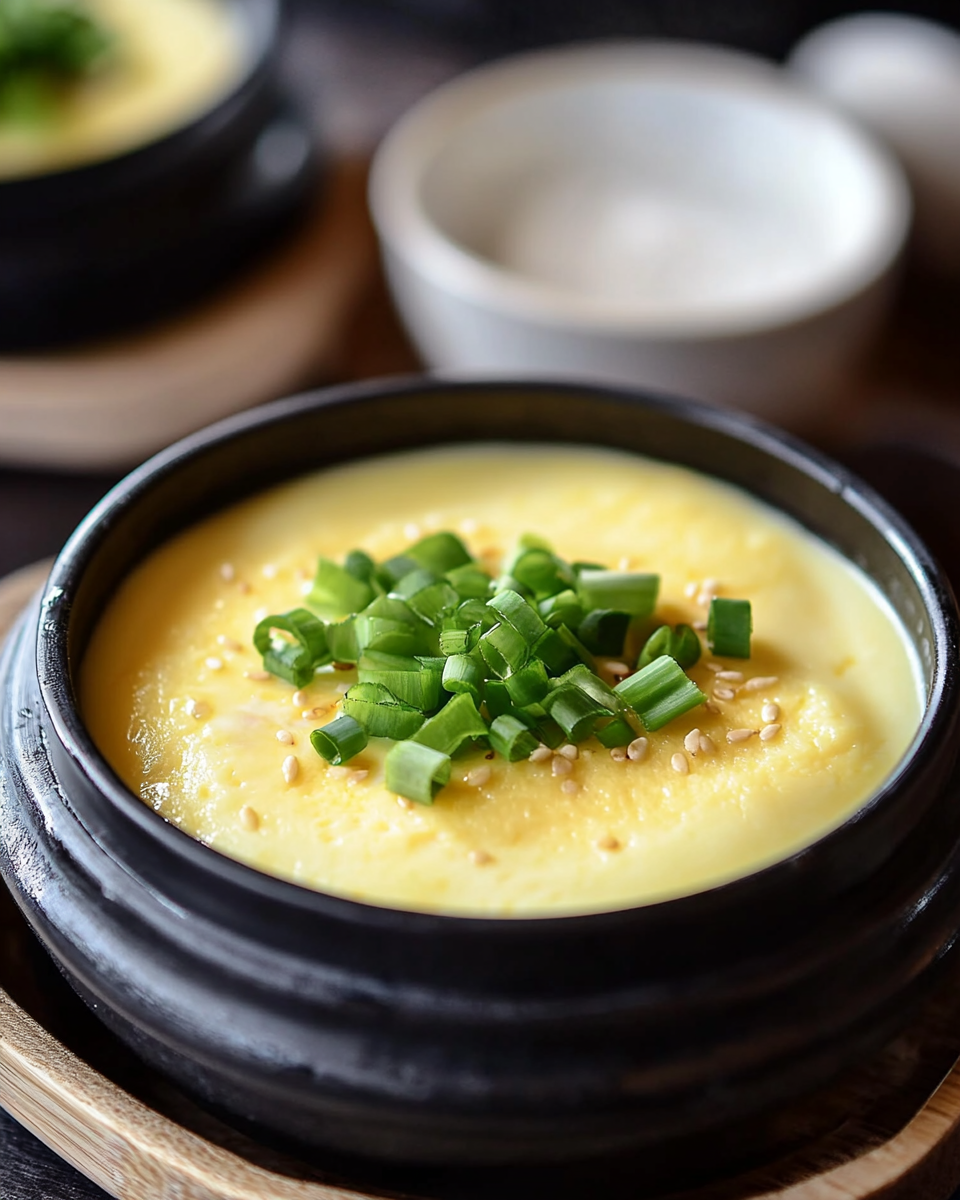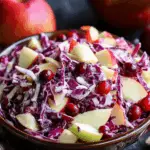Korean Steamed Egg Custard, or Gyeranjjim, is a beautifully delicate dish with a texture that melts in your mouth. Its soft, velvety surface glistens under a light drizzle of sesame oil, with fresh scallions adding a pop of vibrant green. Served hot in a simple earthenware bowl or ceramic dish, this custard offers comforting warmth with every spoonful.
Perfect as a side dish or a light snack, this steamed egg custard embodies the essence of Korean home cooking—simple, nutritious, and satisfying. It pairs wonderfully with bold, spicy main dishes, providing a gentle balance that soothes the palate. Its effortless preparation and elegant presentation make it a favorite for weeknight dinners and special occasions alike.
Full recipe:
Ingredients:
-
4 large eggs
-
1 1/4 cups water or anchovy broth
-
1/4 teaspoon salt
-
1/4 teaspoon fish sauce (optional)
-
1 scallion, thinly sliced
-
1/2 teaspoon toasted sesame oil
Directions:
-
Crack the eggs into a mixing bowl and gently whisk until yolks and whites are combined without creating too many bubbles.
-
Add the water or broth, salt, and fish sauce (if using). Stir gently to combine, then strain the mixture through a fine sieve into another bowl to achieve a smooth texture.
-
Pour the egg mixture into a heatproof bowl or a small pot that fits inside a larger pot. Cover the bowl loosely with a lid or foil.
-
Bring water to a gentle boil in a larger pot or steamer. Place the egg bowl inside the pot on a rack or directly in the water (if using a pot-in-pot method).
-
Steam the eggs over medium-low heat for about 12–15 minutes, or until the custard is softly set and slightly jiggly in the center. Avoid high heat to prevent bubbles or cracks.
-
Remove from heat and drizzle the toasted sesame oil on top. Garnish with sliced scallions. Serve immediately.
Prep Time: 5 minutes | Cooking Time: 15 minutes | Total Time: 20 minutes
Kcal: Approximately 90 kcal per serving | Servings: 2-3 servings
Cultural Significance and Popularity
In Korea, food is deeply intertwined with culture and tradition, and Gyeranjjim holds a special place on the dining table. It is often served in traditional Korean meals, whether at home or in restaurants, as a complementary dish. The warmth and softness of this steamed egg custard make it especially comforting during colder months or when someone is feeling under the weather. It’s also a popular dish for children and elders due to its mild flavor and easy digestibility.
The beauty of Gyeranjjim lies in its versatility and simplicity. It can be made with basic pantry ingredients such as eggs, water or broth, salt, and scallions, yet its gentle flavor and luxurious texture elevate it to something truly special. Because it is steamed rather than fried or boiled, the egg custard maintains a moist, airy consistency that is impossible to replicate with other cooking methods.
The Science Behind the Texture
One of the defining features of Gyeranjjim is its unique texture—soft, custard-like, yet fluffy and smooth. Achieving this texture requires gentle cooking at a low temperature, usually by steaming or using a double boiler method. The key is to avoid high heat, which can cause the eggs to curdle or become rubbery.
Straining the egg mixture before steaming also plays an important role in producing the silky, lump-free consistency. The fine sieve removes chalaza (the stringy part of the egg white) and any bubbles formed during whisking, ensuring a uniform custard. The gradual cooking process coagulates the proteins evenly, giving the dish its characteristic jiggly but tender texture.
Variations and Flavor Enhancements
While the traditional Gyeranjjim recipe is simple, many cooks like to add subtle variations or flavor boosters to personalize the dish. For example, some use anchovy broth or kelp broth instead of plain water to add a delicate umami flavor that complements other Korean dishes. Fish sauce or soy sauce can also be added in small amounts for extra depth of taste.
Other popular additions include finely chopped vegetables like carrots or mushrooms, or small bits of seafood such as shrimp or clams, which can add texture and nutrition. Garnishing with toasted sesame oil and thinly sliced scallions enhances both aroma and appearance. Some recipes also incorporate mild chili powder or toasted seaweed flakes for a touch of spice or crunch.
Nutritional Benefits
Gyeranjjim is not only delicious but also quite nutritious. Eggs are an excellent source of high-quality protein, containing all essential amino acids needed for muscle repair and growth. They also provide important vitamins such as B12, riboflavin, and choline, which support brain health and metabolism.
Because the dish is steamed rather than fried, it is relatively low in calories and fat, especially when made with water or light broth. The use of minimal seasoning and natural ingredients makes Gyeranjjim a wholesome option suitable for people looking to eat clean or maintain a balanced diet. Additionally, it is naturally gluten-free and can be enjoyed by those with gluten sensitivities.
How to Serve and Pair Gyeranjjim
Gyeranjjim is traditionally served as a banchan, or Korean side dish, making it an excellent accompaniment to rice, grilled meats, kimchi, and other bold-flavored Korean dishes. Its gentle flavor helps balance spicy and fermented dishes, providing a cooling and soothing contrast on the palate.
For a simple meal, Gyeranjjim can be paired with steamed rice and kimchi for a light yet satisfying combination. In Korean BBQ meals, it serves as a perfect side to grilled beef or pork, providing a soft textural contrast to the meat. It can also be enjoyed as a comforting snack or breakfast dish.
Some modern variations serve Gyeranjjim in individual ceramic bowls or even add toppings like crispy garlic chips, chili oil, or fresh herbs to enhance presentation and flavor complexity.
Tips for Perfecting Your Steamed Egg Custard
To master the art of making perfect Gyeranjjim, there are a few tips to keep in mind. First, the ratio of eggs to liquid is crucial; typically, about one part eggs to two or three parts water or broth yields the best custard texture. Too little liquid can make the dish dense, while too much can prevent it from setting properly.
Second, whisk the eggs gently to avoid excessive bubbles that create unwanted air pockets. Straining the mixture is highly recommended for a smooth finish. Use moderate heat and avoid boiling during the steaming process to prevent the custard from cracking or forming holes.
Lastly, covering the bowl loosely while steaming helps trap steam and heat evenly, ensuring the custard cooks gently without drying out on top. Timing is also important—checking doneness at around 12 to 15 minutes usually works well.
Why Gyeranjjim is Perfect for All Skill Levels
One of the best things about Korean Steamed Egg Custard is its accessibility for cooks of all skill levels. The ingredients are affordable and usually on hand, and the method is straightforward. Even beginners can create an impressive, restaurant-quality dish with a little practice.
For those new to Korean cooking, Gyeranjjim serves as a gentle introduction to traditional Korean flavors and cooking techniques. It’s a quick dish that doesn’t require complicated preparation or expensive ingredients, yet offers rich cultural and culinary value.
Conclusion
Korean Steamed Egg Custard (Gyeranjjim) is a shining example of how simple ingredients and techniques can create a dish that is greater than the sum of its parts. Its soft, silky texture combined with subtle savory flavors makes it an indispensable comfort food in Korean cuisine. Whether served as a side dish, snack, or light meal, it is both nourishing and deeply satisfying.
The versatility of Gyeranjjim allows it to be customized to suit different tastes and dietary needs, while its easy preparation makes it perfect for busy cooks and beginners. As a nutrient-rich, low-calorie dish, it fits well into a healthy lifestyle without sacrificing flavor or enjoyment.
If you’ve never tried making Gyeranjjim before, it’s worth a place on your cooking roster—not only to experience a beloved Korean classic but also to enjoy a dish that soothes, comforts, and delights with every bite.






